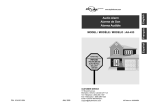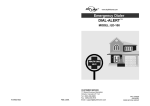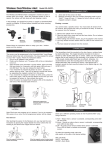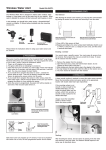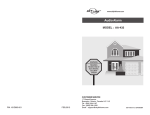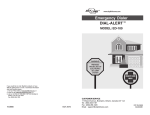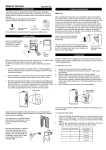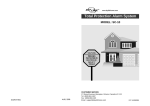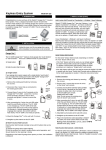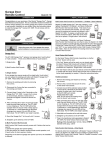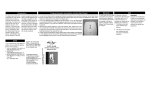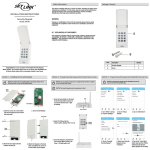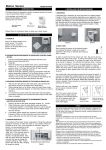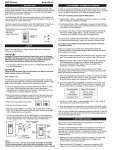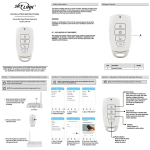Download Set up the Audio Sensor Introduction Program the
Transcript
Introduction The Audio Sensor (AS-433) is designed to detect sound frequency from the siren of your existing security system. Once the siren goes off, the Audio Sensor will be activated and therefore triggers the emergency dialer (AD-433S) by sending radio frequency (RF) signal or through hardwire connection. The Audio Sensor is designed to recognize only the siren from your existing security system, therefore it will not pick up any background noise if the sensor is installed properly. The sensor can also work in conjunction with all of the Skylink receivers that incorporate the Rolling Code Technology (Security Control Panel SC001, Emergency Dialer AD-1010, Audio Alarm AA-433, and Silent Alarm SW-433). Installing the Audio Sensor Set up the Audio Sensor 1. Place the Audio Sensor as close as possible to the siren or alarm unit of your existing security system. This distance between the sensor and the siren should be less than 6 inches. Note: Selecting the place to locate the AS-433 is very critical, since this will affect the operation and performance of the sensor. You should avoid placing the Audio Sensor near any unwanted sound sources (such as TV, stereo) to eliminate false trigger by background noise. 1. Plug in the AC adapter and ins ert the wire to the “DC 9V” jack. If there is no electrical outlet nearby the audio sensor, you may use the 9V alkaline battery as the main power source. If both power suppliers are connected, the 9V adapter will be the main power, 9V alkaline battery will become the backup power supply. 2. Turn on the unit to test mode (by sliding the ON/OFF/TEST switch to “TEST”). The red light indicator will flash once you turn on the unit. 3. Allow 15 seconds for the sensor to warm up. 4. Rotate the “Volume” to “LO”. 5. If the light indicator on the AS-433 turns on as the siren is sounding, that means it can detect the sound from the siren and the installat ion of the AS-433 is now completed. 6. If the red light indicator does not turn on, which means the sensor cannot hear the siren. So you need to increase the volume setting by slightly rotating the “Volume” switch. 7. Activate the siren again and see if the audio sensor can hear the siren. If the red light indicator does not turn on, repeat step 6 until the red light indicator turns on. 2. Plug in the DC adapter cord to the DC jack on the Audio Sensor, and plug in the other end to an electrical outlet. If there is no electrical outlet nearby, the Audio Sensor can be operated by 9V battery as well. Please refer to External Jack - External power supply for more detail information. 3. Apply the Velcro to the back of the sensor as well as the wall. 4. Locate the Audio Sensor AS-433 and make sure it is secure. Caution: Please make sure the Audio Sensor can only be triggered by the real alarm siren. Some of the alarm systems will emit other sounds under different situations such as entry delay deeps (this is to warn the user the alarm has been triggered, user has to enter the password within a short period of time otherwise the alarm will go off). Please make sure the Audio Sensor can only detect the intented alarm sound pattern. Since the intented alarm is usually a lot louder than other sound patterns. If the AS-433 c an detect other sound patterns from the alarm systems, please adjust the "Volume" so that it can only detect the intented alarm. Program the Audio Sensor to the Security Control Panel (SC-001) PANIC BUTTON Set up the Audio Sensor VOLUME LO / HI DELAY LO / HI MIC 8. You should test the sensor several times in order to ensure it can hear the siren. Caution: You should keep the “Volume” setting as low as possible in order to eliminate false trigger by any background noise. DC 9V TEST / ON EXT. JACK 1. Set the ON/OFF/TEST switch on the side of the Audio Sensor to “ON and allow 15 seconds for the unit to warm up. 2. Enter the current MPIN (Master Personal Identification Number) on the SC001. 3. Press [B]. 4. Press the number key to identify which zone to add the Alarm Sensor to, zone [1, 2, 3, 4]. It is not recommended to program this sensor to zone 1 or 2 because these zones are intended for Delay Mode. 5. The zone light(s) will flash for eight seconds. * 6. While the zone light(s) are flashing, press [ ]. Now both the green and red lights flash for 30 seconds. 7. While the zone lights are flashing, activate the Audio Sensor by pressing the Panic button on the AS-433. You will hear a long beep from the SC001, the zone light will stop flashing and the Audio Sensor will now communicate to that zone. 1. Set the ON/OFF/TEST switch on the side of the Audio Sensor to “ON” and allow 15 seconds for the unit to warm up. 2. Press [L], [5] on the keypad of the dialer when in clock mode, the display will show “L5 IdcodE”. 3. Activate the Audio Sensor by pressing the Panic button on the AS-433. When the red light indicator turns on, that means it is transmitting the signal to the dialer. Once the dialer has learned the signal, the display will return to clock mode. Program the Audio Sensor to the Audio Alarm (AA-433) 1. Set the switch on the side of the Audio Sensor to “ON”. Wait 15 seconds to warm up. 2. With only the “ON” light lit on the Audio Alarm, press and hold the learn button located on the bottom of the Audio Alarm. 3. While pressing down on the learn button, activate the Audio Sensor by pressing the Panic button on the AS-433. 4. If a connection has been made, the Audio Alarm will stop beeping and make a continuous tone until the black learn button on the Audio Alarm is released. Battery Maintenance When the voltage of the 9V battery drops to a certain level, the audio sen-sor will notify you by flashing the red light indicator every 8 seconds. This indicates the 9V battery needs to be replaced. Note: When the 9V adapter is connected to the AS-433, the low battery indication will be disabled. Normal Operation External Jack Once you have installed your audio sensor properly, you should not change the setting since it will affect the operation of the sensor, and therefore may cause false alarm or malfunction. In order to activate the audio sensor, it has to detect the siren or similar sound source for a fixed amount of time, either 4 seconds or 8 seconds. This timing can be set by adjusting the Delay Time setting. When the Delay time is set to “LO”, the AS-433 has to detect the siren for approx. 4 seconds in order for it to be triggered. When the Delay time is set to “HI”, this timing will be changed to 8 seconds. This will eliminate the chance of false alarm. Once the audio sensor is activated, it will send a signal to trigger the emergency dialer (AD-433S). The dialer will then start dialing out all the preset phone numbers and ask for help. Warranty If, within one year from date of purchase, this product should become defective (except battery), due to faulty workmanship or To replace the battery: 1. Turn off the audio sensor and disconnect the AC adapt er from the sen- materials, it will be repaired or replaced, without charge. sor (if the adapter is connected). Proof of purchase is Caution: If the N/C hardwire connection is made, disconnecting the power or turning off the Audio Sensor will trigger the dialer. Therefore, required. before replacing the battery, or turning off the power, please disable the dialer. 2. Pry off the battery cover and remove the old battery from the battery compartment. 3. Connect the new 9V alkaline battery to the connector wire and place the battery inside the battery compartment. 4. Slide the battery cover back on. 5. Turn the Audio Sensor to “ON” mode. FCC The Remote Control is approved by the FCC and it complies with Part 15 of the FCC Rules. Its operation is subject to the following two conditions : 1. This device may not cause harmful interference. 2. This device must accept any interference that may cause undesired operation. WARNING: Changes or modifications to this unit not expressly approved by the party responsible of compliancecould void the user’s authority to operate the equipment. Normally Closed (N/C) Relay Dry Contact The audio sensor can work with the dialer through radio frequency (wireless) or Normally Closed Contact (wire connection). You may insert one end of the wire (included) to the audio sensor and connect the other end of the wire to the N/C contact of the emergency dialer (please refer to the user manual of the dialer for more detail information). If the sensor is activated, it will trigger the dialer through the wire connection. Caution: Once the hardwire connection is established between the dialer and the Audio Sensor, the Audio Sensor will be activated if the connection is broken or if the Audio Sensor is turned off. External power supply – DC 9V The Audio Sensor can be powered by either 9V alkaline battery or external AC power adapter. When the AC adapter is plugged in, the 9V alkaline battery works as a back up battery. In case of a power failure, the audio sensor can still operate normally. On the other hand, you can use the 9V alkaline battery as the primary power source as well if 9V DC is not connected. NOTE If you would like to order Skylink’s product or have difficulty getting your Skylink’s product to work, please : 1. visit our website FAQ at www.skylinkhome.com , or 2. email us at [email protected] 3. call our toll free at 1-800-304-1187 from Monday to Friday, 9 am to 5 pm EST. Fax +800 286-1320 Skylink will not be held liable or responsible for any misuse or application of this product other than for its intended use. CUSTOMER SERVICE 17 Sheard Avenue, Brampton, Ontario, Canada L6Y 1J3 Email:[email protected] http://www.skylinkhome.com P/N. 101A342 Rev.0 US Patent 6243000B1 ©2004 SKYLINK GROUP ® ® are registered trademarks of their respective corporations Program the Audio Sensor to the Emergency Dialer (AD-433S) AUDIO SENSOR USER'S INSTRUCTIONS (Model AS-433)



